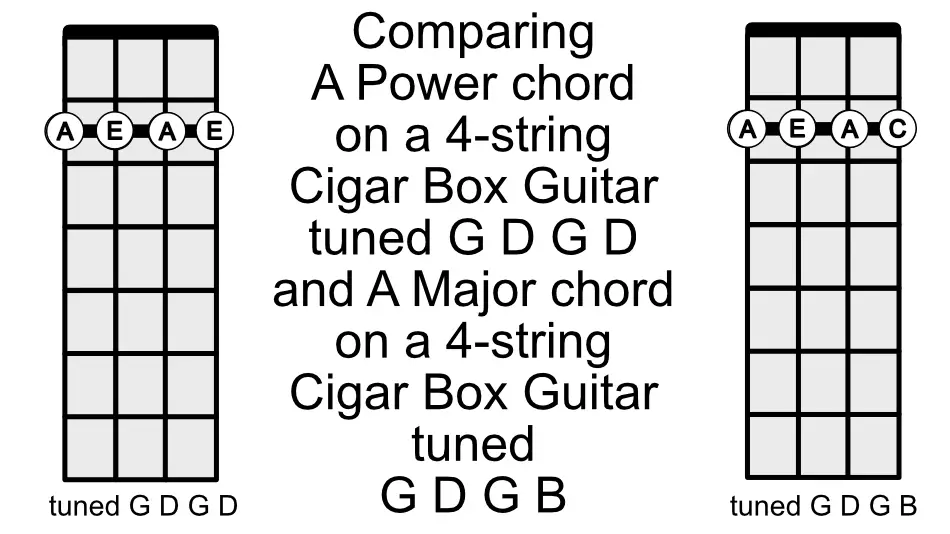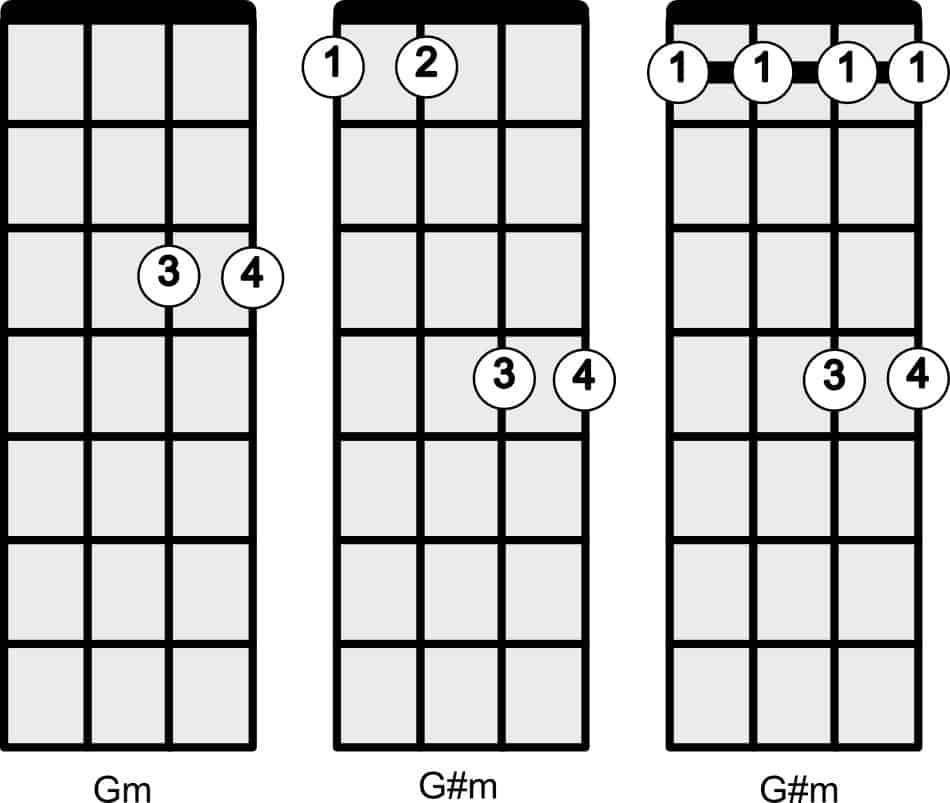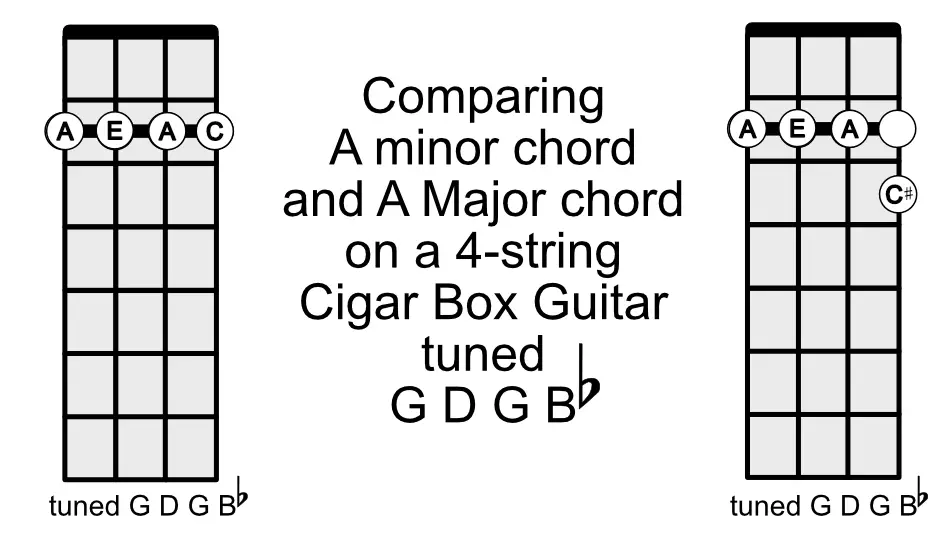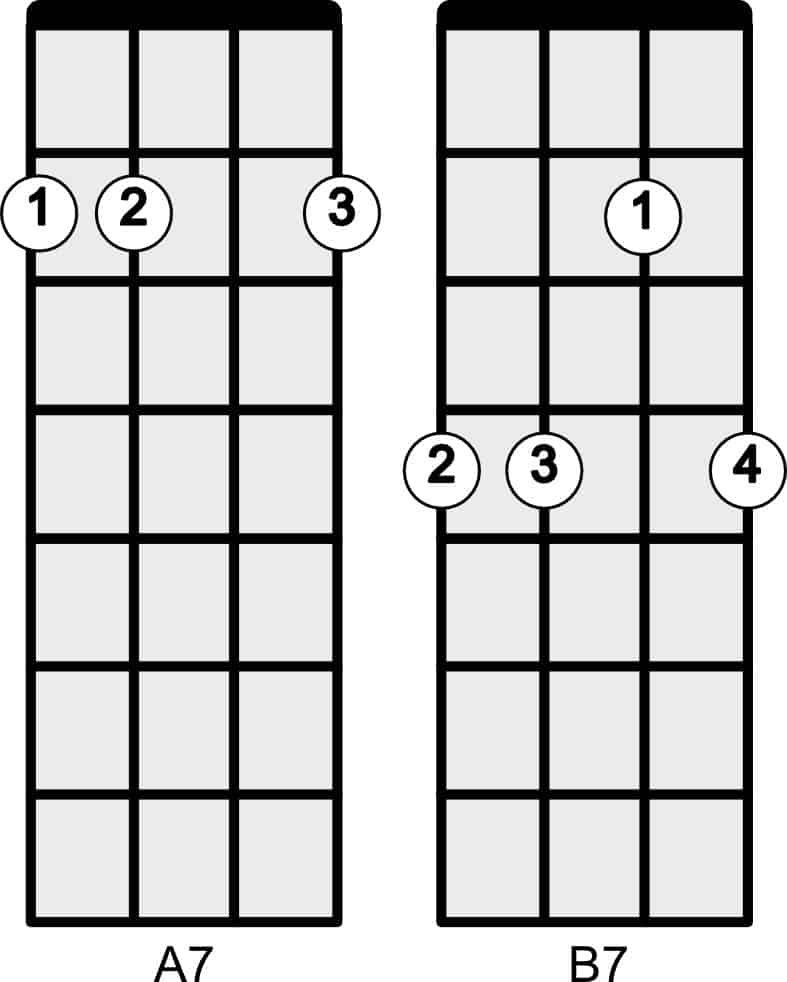Transferring knowledge from a 3-string guitar to a 4-string means deciding what tuning you’d like with that extra string. Of course, you can retune all the strings, but for now we-re going to look at 3 different notes that we can tune the top string to whilst keeping the lower 3 strings at G D G:
- G D G D – tuning to power chord
- G D G B – tuning to a Major chord
- G D G Bb – tuning to a minor chord
Tuning a 4-string Cigar Box Guitar to G D G D
This gives a similar but fuller sound to the strummed chords. Since the top note is tuned to the same as the 3rd string, it’s fairly easy to find the notes on the top string:

Playing the open chord or a 1-finger barre chord on a 3-string in G D G ( or any open 5th tuning) gives you the power chord that is named by the note that is on the bottom bass string and this is the same for 4-stringed tuning G D G D as seen below:

If you’ve been used to playing a 3-string Cigar Box Guitar in open 5th tuning, such as G D G or D A D or E B E, then this could be a good solution for you. There isn’t a big learning curve. You’ve already worked out 1-finger power chords and you are just adding to the depth of sound. The notes on the new string aren’t hard to work out as they are just an octave above the 3rd string.
Any harmonies you have worked out using the bottom 2 strings can now also be used on the top 2 strings. For instance, playing a melody on either of the G strings and playing the harmony 2 frets lower on the D strings gives a pleasing sound.
Tuning a 4-string Cigar Box Guitar to G D G B
Whereas doubling the D string enables easy power chord playing, adding a B as the top string gives a Major chord when the strings are strummed. It is an inversion ( which just means the notes are in a different order)
For instance, the G Major chord is made up of G B and D ( the B is a Major 3rd above the G and the D is a 5th above the G) Instead of playing the 1st, 3rd and 5th notes in that order, G D G B tuning gives the 1st, 5th, 1st and 3rd notes in that order.
So now, instead of 1-finger barre power chords, you can play 1-finger barre Major chords. As before, the name of the Major chord is the same as the note on the bottom bass string:

The notes on the fretboard will require a little bit of learning since the top string is now tuned differently to any other string on the guitar:

How to Play The Minor Chord On a 4-String Guitar tuned G D G B
- omit the top string
- fret the top 2 strings 3 frets higher than the barre
- try an alternative tuning: either G D G D or G D G Bb
The major chord is a fuller sound than the power chord, but it does mean that you cannot play a power chord to stand in for a minor chord by playing across all 4 strings whether open or fretted. One option is to omit playing the top string if you need to play a minor chord, substituting the 3- string power chord.
This is a fairly easy option if you only have 1 minor chord to play in the piece but it gets trickier if you have lots of minor and major chords.
You can use this shape to play minor chords in which the 2 top strings are both fretted 3 frets above the barre:

However, I find this a real stretch particularly on the lower frets.
You can avoid using the major 3rd on the top string and retune your guitar to use the 5th again (as in the G D G D option above) but I have been experimenting with another solution and I’m pretty happy with it.
Tuning a 4-string Cigar Box Guitar to G D G Bb
You might wonder why on earth I’d choose such an unusual tuning. This is a way of tuning your guitar to play a minor chord on open strings or 1-finger barre chords.
For me , the beauty of this tuning is that just raising that top string by one fret gives me the Major chord and it’s a really easy way to play Major and minor chords in the same piece with 1-finger barre chords and an added finger:

When I’m playing a piece with lots of Major chords and minor chords, I’m finding it a really easy option to just add the extra finger to raise the minor 3rd to a Major 3rd which changes the minor chord to the Major chord.
This is easier for me than playing with the guitar tuned to the Major chord and dropping the top note down a fret, especially on the higher frets.
See which works better for you:
- tuning to the Major chord and dropping the top string a fret to play minor chords or
- tuning to the minor chord and raising the top string by one fret for the Major chord.
I have also made a table of the notes on the fretboard for this tuning:

Playing 7th Chords On A 4-string Guitar
When we talk about 7th chords, we usually mean dominant 7th ( we just don’t include the word dominant). This is made up of the 1st, 3rd, 5th and flattened 7th notes of the Major scale.
There are also 2 other kinds of 7th chords: the Major 7th and the minor 7th.
The Major 7th chord is the 1st, 3rd, 5th and 7th notes of the Major scale.
The minor 7th chord is the 1st, flattened 3rd, 5th and flattened 7th notes of the Major scale.
So for G:
- G7 is G B D F
- G Maj7 is G B D F#
- G m7 is G Bb D F
I thought I’d just give you a couple of pointers on how to easily play 7th chords on 4-string guitars tuned to G D G B and G D G Bb:
Dropping the 2nd string down 2 frets on a guitar tuned to G D G B will give you the 7th chord

Dropping the 2nd string down 1 fret on a guitar tuned to G D G B will give you the Maj7th chord

Dropping the 2nd string down 2 frets on a guitar tuned to G D G Bb will give you the m7 chord
Further Reading
I intend to write some pieces for 4-string guitar and I have set up a menu on the home page where you can access these as I write them, but you might also be interested in this article which I wrote a while back: https://beginnercbg.com/beginner-chords-for-a-4-string-cigar-box-guitar/
